Cloud spending will make up for 14% of total enterprise IT spending in 2024–up from 9% in 2020. As the demand for the cloud is increasing, so are the cloud costs. However, organizations are now realizing that high cloud costs make up an increasing part of their total IT spending.
But here’s an even more shocking statistic: According to a report by Gartner, over 70% of cloud costs are wasted.
As a result, it has become more important than ever for organizations to pursue effective cloud cost analysis and continually monitor cloud spending. This blog will cover what cloud cost analysis is, and the best practices to implement the same.
What Is Cloud Cost Analysis?
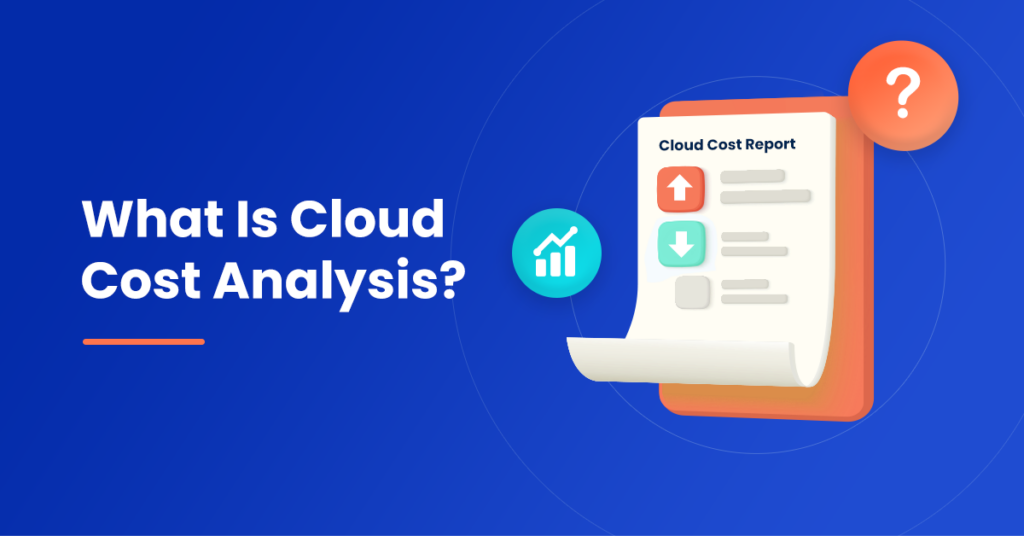
Cloud cost analysis provides in-depth insights into where your cloud budget is being spent and whether you are able to use the present resources efficiently or not. It gives you an understanding of the costs associated with your overall cloud infrastructure. Ideally, cloud cost analysis involves monitoring how much you’re spending on different services or resources and looking for opportunities for cost control.
What Is Cloud Cost Optimization?
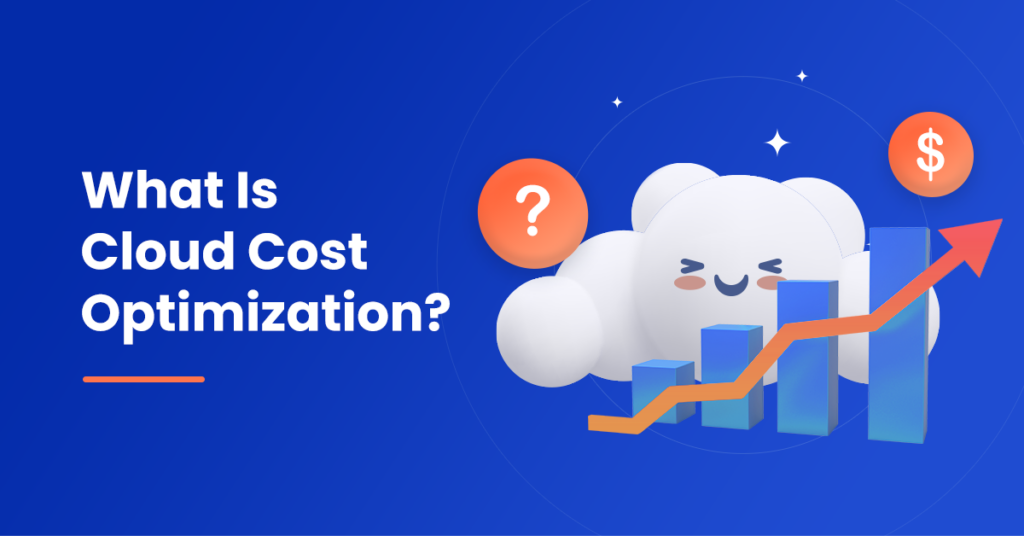
Cloud cost optimization is the continuous process of refining and improving your cloud system to minimize overall costs. Cost-optimized cloud operations can fully utilize the available resources and meet all the functional requirements while keeping the lowest price point possible.
Cloud cost optimization at its basic level includes:
- Creating asset awareness across the entire organization through tagging and tracking
- Collecting important metric data for yearly and monthly cost analysis
- Establishing a data-driven purchasing strategy
- Analyzing all the existing resources for efficiency and utilization
Best Practices For Cloud Cost Analysis!
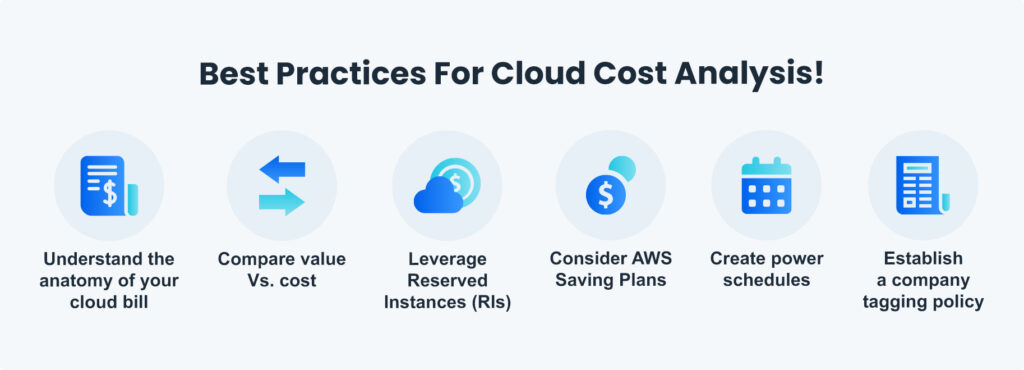
Understand the anatomy of your cloud bill
Cloud billing data can be extremely complex– AWS has over 200,000 SKUs for individual products, some of which are even billed at per-second resolution. Behind every spending is a complex interconnection of cloud charges like data transfer, gigabytes of storage, and instance hours.
That is why the first step towards cloud cost optimization should be understanding and analyzing your current cloud bill. You can only cut down on costs when you know where you are spending right now and why.
In your cloud bill, every row will include details about the resource used and its usage quantity. Ideally, these are the attributes you will see in your cloud bill:
- Amount of resources used
- The total time period the resource was used
- Rate charge
- Location of the resource
- Resource ID
- Other metadata attributes like project or account
Understanding your cloud bill allows you to detect even the smallest changes in your cloud usage. Cloud usage bills give you power through the granularity of data and help you address small issues before they cause huge problems and lead to overspending.
Compare value Vs. cost
When it comes to cloud analysis, it’s important always to remember that this whole process isn’t just about cutting down costs. It’s about identifying areas of waste and ensuring you can get the maximum value for every dollar spent.
Instead of fixating on cost-cutting and reaching a hypothetical budget number, focus on these questions instead:
- What are the main services/products you provide to your customers?
- How much does it cost to provide those services through the cloud?
- Is there a way to optimize the spending per unit to make sure you get more value at the least cost possible?
Leverage Reserved Instances (RIs)
If you are using AWS, you may already know that Amazon EC2 Reserved Instances are one of the best and most obvious ways to control computing costs. EC2 provides 72% more discounted hourly rates as compared to On-Demand instance pricing.
But before you jump on the RIs bandwagon after looking at the discounted rates, keep in mind that there are also some disadvantages of RIs:
- Predicting usage over one or even three years can be difficult, especially if no historical data is available.
- With businesses wanting to move to the public cloud due to the scalable pay-as-you-go model, capital costs with RIs may end up taking them back to sunk costs and long-term commitment contracts.
- Creating extra capacity for a particular type of instance can be costly, complicated, and time-consuming.
The most optimum use cases for RIs are for applications with stable usage patterns, which will, in turn, allow you to achieve the highest savings with stable ROI while lowering unused resources in the future.
To get the most out of RIs and optimize cloud costs, keep these best practices in mind:
- Prefer to buy reserved capacity only for instances that are always running.
- For instances with stable usage patterns that aren’t always running, buy only the minimum number of RIs you will need to keep the application running.
- Centralize RIs to ensure if one team isn’t using the resource, other teams can use it.

nOps provides RI commitment management through ShareSave. You get automated, real-time and risk-free lifecycle management of EC2 and RDS commitment. The goal is to help you save more without risking overcommitment of RIs. The optimization by nOps gives you the flexibility to switch different commitments and types–as and when needed.
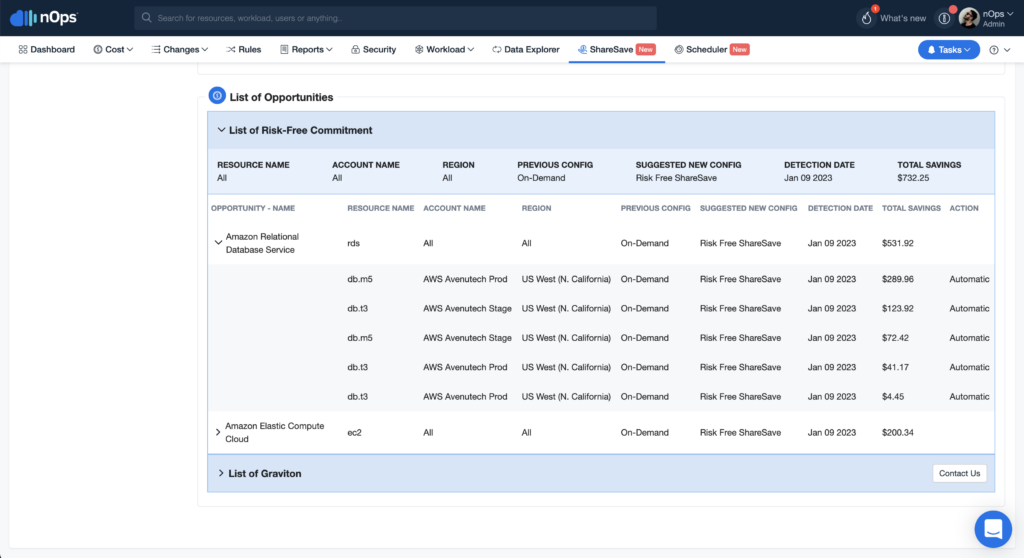
Consider AWS Saving Plans
AWS Saving Plans offer wide savings over On-Demand EC2, but they require a minimum amount of computing power commitment. The price rate is usually measured in dollars per hour over a period of one or three years. Also, any additional usage over the committed minimum amount is charged according to the standard on-demand rate. AWS Saving Plans are also not applied to existing RIs.
Here’s how AWS Savings Plans work:
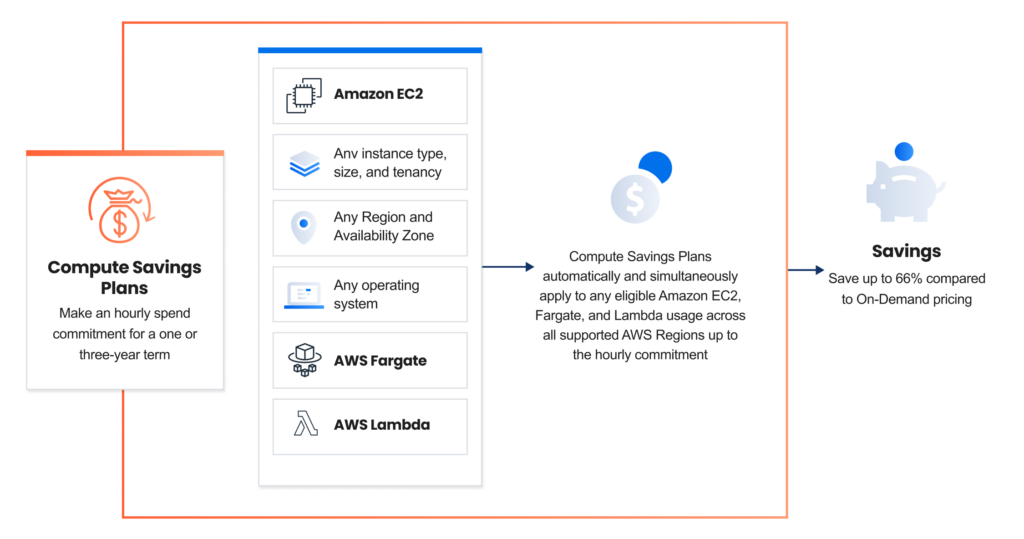
There are two types of Savings Plans available:
- Compute Savings Plan: These plans offer the most flexibility and can reduce overall costs by over 66% compared to Convertible RIs. These plans get automatically applied to EC2 instance usage regardless of the region.
- EC2 Instance Savings Plans: These can apply to any instance family within a specified region and provide discounts of up to 72% compared to Standard RIs.
While AWS Saving Plans and RIs may seem similar, the two have some key differences.
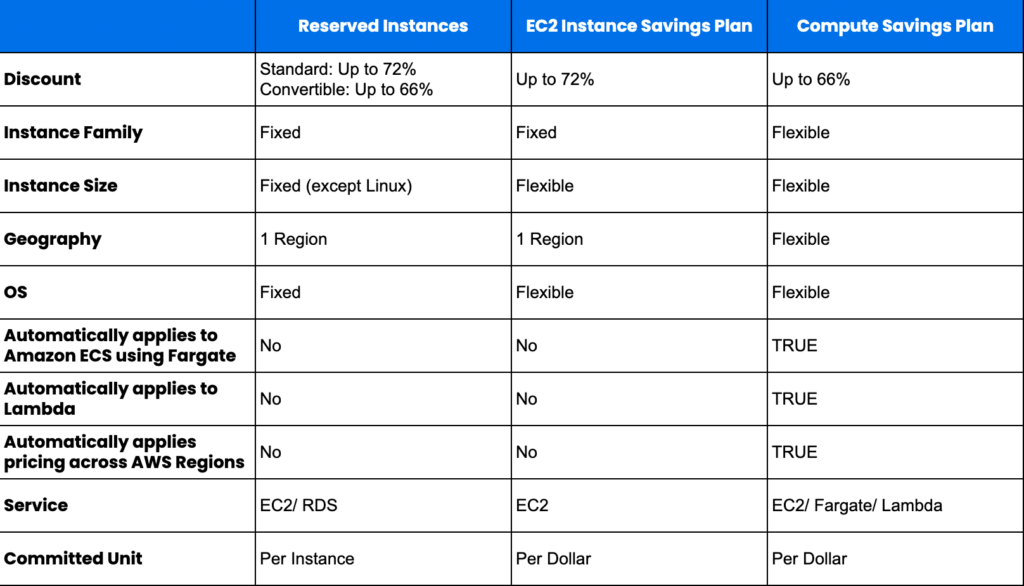
Create power schedules
Since you pay by the hour for running public cloud instances, the less time they run, the more money you save. While many workloads don’t need to run 24/7, it’s easy to forget to shut them down.
For instance, some instances that may only be required to be run on weekdays can be powered off on the weekend.
You can create a power schedule that shuts down and restarts instances to ensure that they are not left running overnight on weekends and thus save on costs.
Establish a company tagging policy.
Cloud cost optimization can only be successful in an organization if you create a culture of financial and resource usage transparency. Before you go into the ‘how’ of cutting down cloud costs, you need to make all the stakeholders aware of the ‘why’ behind cloud cost optimization.
Cost allocation tagging doesn’t just help you get a granular idea about your cloud spending across different teams and departments, but it also makes people aware of how many resources they are using.
A company-wide tagging policy will lead to continuously enforcing tags and monitoring monthly cloud expenditures. You can then use tags to generate showback or chargeback reports to make departments aware and responsible for their cloud usage.
With nOps Tag Explorer, you can assess tags currently attached to resources and even detect untagged ones. You can use tags to better understand the cost of all resources, environments, departments, projects, teams, and customers. You can also create showback and chargeback cost allocation reports for any period to better understand your organization’s overall cloud spending.
Look into reducing EBS costs
Amazon Elastic Block Storage (EBS) is a high-performance block storage service that is designed to specifically work with EC2. You can attach multiple EBS volumes to a single instance if all the resources present are in the same availability zone.
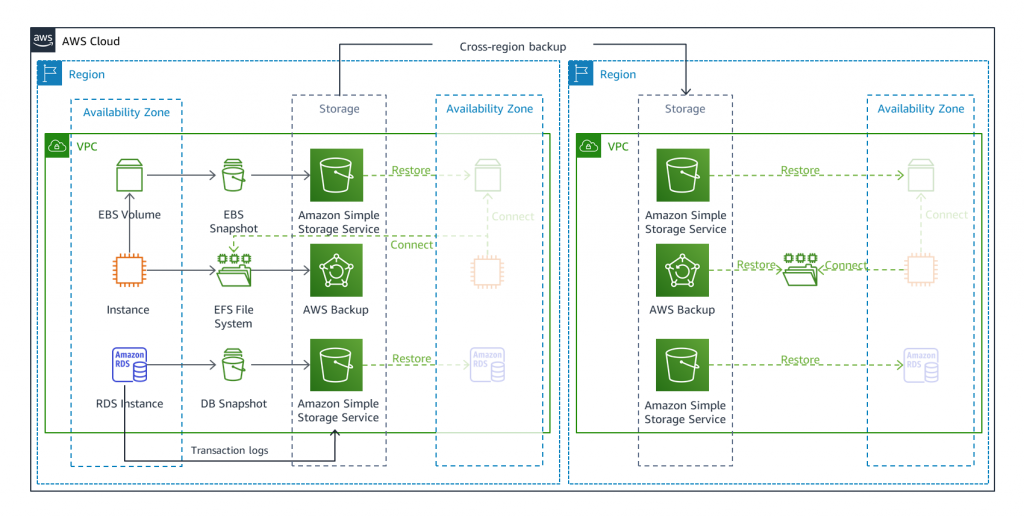
Image Credits: AWS
Here are some ways you can reduce EBS costs:
- Find detached EBS volumes: Look for any EBS volumes that do not get automatically deleted when the EC2 resource they are attached to gets terminated. To find and detach EBS volumes, look for the AWS attribute ‘state’, which is set to ‘available.’
- Find underutilized EBS volumes: Identify underutilized EBS volumes by changing their volume type or downsizing them. To determine the EBS throughput, you can monitor the read-write access of EBS volumes.
- Look for EBS volumes attached to stopped EC2s: While you only get charged for EC2 instances when they are running, EBS volumes continue to retain information even when the instance they are attached to gets stopped–and you continue paying for those EBS volumes. If EC2 instances have been stopped for a long, it is better to create an EBS snapshot instead and delete the volume. That is because Amazon EBS snapshots get billed at a much lower rate than EBS volumes.
Optimize data transfers
Data transfers are an often overlooked factor that contributes to increased AWS cloud bills. The total data transfer costs can increase significantly depending on the data type and your users’ average usage patterns. That is why creating a data transfer strategy is important to ensure you are always within your budget.
To decrease data transfer costs, start by looking into your AWS bills to discover cost patterns and spending trends. Then focus on the following cost-saving strategies for optimum and cost-effective data transfers:
- If possible, keep data within the same availability zone and region.
- Use a less expensive region for data transfers. (Make sure to check the data transfer costs for different regions).
- Use a content delivery network (CDN) to lower data transfer costs while also ensuring fast delivery to end customers.
Leverage Spot Instances
AWS EC2 Spot Instances are unused EC2 instances that are 90% cheaper than On-Demand instances. AWS sets the hourly spot price for each Spot instance type based on their availability zone, supply, and demand. Spot instances can be a great cost-effective solution if you can be flexible about the availability of your applications.
Spot instances are ideal for error-tolerant, stateless, and flexible applications like background processing, batch jobs, and data analysis. You can also easily combine spot instances with Savings Plans, RIs, and On-demand instances.

How Can nOps Supercharge Cloud Cost Analysis?
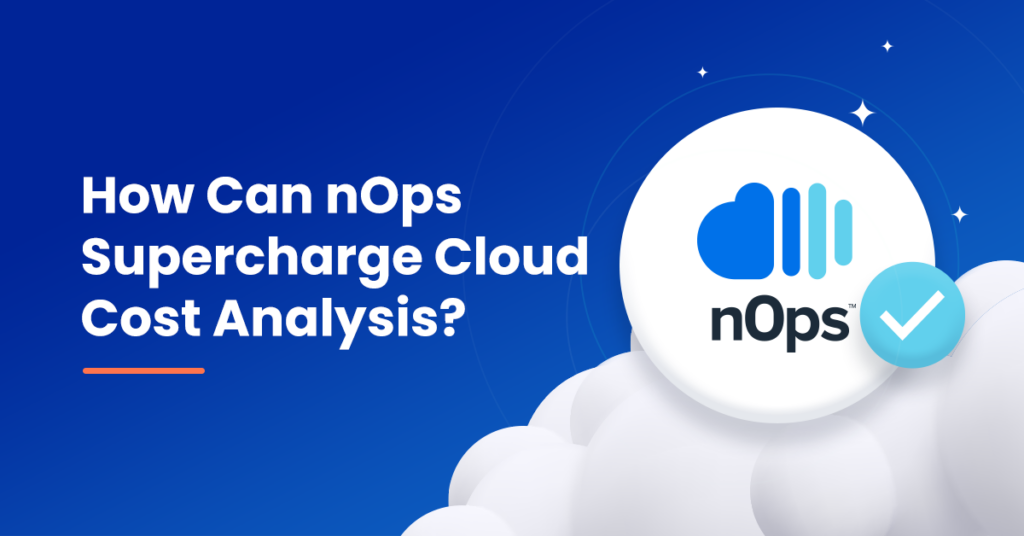
nOps is an automated AWS cloud management tool that can reduce your AWS costs by over 50%. It can track your AWS costs across different projects, accounts, resources, regions, services, costs, and custom tags. With nOps, you get a real-time multi-cloud view of all of your AWS environments that directly affect costs.
Here are some of the many ways nOps can cut down on AWS costs:
- Assess tags attached to resources with nOps Tag Explorer for granular billing information and highlight untagged resources
- Access cloud infrastructure inventory with just one click
- View cost history and audit trail for all the AWS resources
- Optimize utilized resources to do smarter Spot Instances planning
- Use ShareSave to save up on Reserved Instance costs
Your team focuses on innovation, while nOps runs optimization on auto-pilot to help you track, analyze and optimize accordingly! Our customers can benefit in two key ways:
- First, pay less for what you use without the financial risk.
- Second, use less by automatically pausing idle resources.
Let us help you save! Sign up for nOps today.



